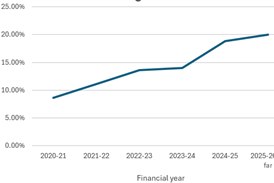Clinical safety must be a top priority and virtual wards can help achieve it by providing patients with the sense of security of being cared for on a hospital ward whilst at home

When my colleagues Mary Brice, Patricia Robinson, and I invented and opened the first virtual ward almost 20 years ago, the only technology we had at our disposal was an Excel spreadsheet for keeping track of our patients, and a landline phone for speaking with them. It took covid-19 and different software – Microsoft Teams – for virtual wards to gain widespread traction across the NHS. So, what constitutes a digitally mature virtual ward by today’s standards, and how will they evolve?
Sponsored by
It is easy to overlook just how central wards are to the smooth running of a hospital. Wards bring order and coordination where there would otherwise be chaos and confusion. That is why hospitals across the globe are organised into wards – even hospitals like the new Royal Liverpool Hospital that are composed exclusively of single rooms. Virtual wards apply this sense of order and coordination to patients receiving care at home.
Every ward has certain defining characteristics, including a fixed number of beds (bed capacity), a team that is based on that ward (ward staff), a set of routines (ward round, obs round, board round, drugs round, and multidisciplinary team meeting), and a central communications hub (nurses’ station).
The same applies with virtual wards. In my view, the role of technology is to recreate these characteristics as effortlessly as possible in the virtual world in order to provide patients with the sense of security of being cared for on a hospital ward whilst at home.
Evidence suggests that virtual wards can be effective in achieving all five elements of the so-called “quintuple aim” of healthcare. They improve the quality of care, reduce its cost, provide a better experience for patients and staff, and reduce health inequalities. Achieving this fifth element, however, requires a concerted effort. It is easy to wrongly assume that everyone lives in a warm, dry home, with their own bedroom, a modern mobile phone, and access to fast, reliable broadband. So, while alternatives to virtual wards must always be available, a digitally mature virtual ward will also make provisions for people who wish to be cared for at home, for example by providing them with internet connectivity and hardware devices.
In the early days, we relied on spreadsheets to admit and discharge our patients and to run our ward and board rounds. Today there is a mature marketplace in virtual ward software, ranging from highly configurable platforms such as Microsoft Teams or Teladoc’s Solo platform, through to specialist, off-the-shelf tools such as Spirit Health’s CliniTouch Vie software, the Inhealthcare Platform, and Huma’s virtual ward platform. There has been a similar leap forward in remote monitoring with a range of tools, from connected sphygmomanometers and thermometers, through to wearables that offer continuous monitoring of vital signs. The software and remote devices should interoperate smoothly with each other, and with any separate electronic medical record system or social care records in use.
There is also a growing range of digital devices allowing clinicians to examine virtual ward patients remotely. Bluetooth-enabled stethoscopes can be used to listen to a patient’s chest, using a mobile phone camera to confirm where the device is positioned. And in care homes in Staffordshire and Scotland, the NHS is trialling high-definition cameras that have otoscope and tongue depressor attachments, allowing clinicians to examine their patients’ ears and throats remotely. Another field demonstrating rapid innovation is remote rehabilitation. The Evolv RehabKit, for example, couples a body tracking camera with artificial intelligence to deliver physiotherapy at home, using gamification to help patients to push themselves and to maintain interest
Clinical safety must be a top priority. On a hospital ward, nursing staff can keep an eye on their patients. This is more challenging on a virtual ward, which is where analytics can help. Technicare, for example, offers continuous remote monitoring, which is designed to predict and detect deterioration early and quickly.
We should keep an open mindset for innovative technology, while not forgetting those defining characteristics of hospital wards that have stood the test of time
So, what developments can we expect from technology? I see three big trends underway. First, algorithms: “impactability models”, will help target virtual ward care to those high-risk patients who are most likely to benefit. Second, low-code/no-code platforms, which allow virtual ward staff to create mobile or web apps designed to improve efficiency using only drag-and-drop application components. Finally, the transformation of everyday consumer technology, such as mobile phone cameras, into clinical-grade devices using artificial intelligence. Companies like Lifelight are said to be only months away from obtaining full regulatory approval to use a mobile phone camera to measure a patient’s pulse, blood pressure, and respiratory rate - reducing the need for dedicated devices and making it much faster and simpler to conduct virtual ward obs rounds. Particularly encouraging is the extent to which these AI tools have been designed from the outset to work equally well with the full spectrum of skin tones and with cheaper and older mobile phones as well as the latest models.
Clearly then, what constitutes a digitally mature virtual ward is continually changing. Indeed, some virtual wards are becoming so advanced that we are seeing hospitals borrowing ideas from them. For example, some hospital wards are introducing “virtual rounding”, where a specialist clinician joins a hospital ward round remotely; others are using digital questionnaires to monitor their patients’ symptoms and wellbeing quickly and systematically. We should keep an open mindset for innovative technology, while not forgetting those defining characteristics of hospital wards that have stood the test of time. The key question to ask is how this technology will improve the quality, efficiency, and equity of my ward, be it in the real or the virtual realm.
Geraint will be discussing Enhancing Efficiencies through Automation at the HSJ Digital Transformation Summit on 9 February.




























